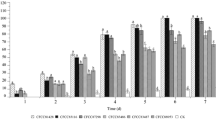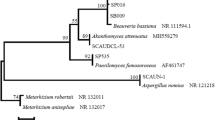Abstract
The entomopathogenic fungus Isaria fumosorosea Wize, formerly known as Paecilomyces fumosoroseus is reported as a promising biocontrol agent for controlling subterranean termites, particularly those belonging to the family Rhinotermitidae. In Malaysia, the family Rhinotermitidae includes two species of subterranean termites with extremely high economic importance; namely Coptotermes curvignathus Holmgren, and the Asian Subterranean Termite (Coptotermes gestroi Wasmann). To comprehend the potential control of this soil-dwelling fungus against these subterranean termites in Malaysia, an investigation was carried out by testing the pathogenecity of 11 isolates against these termite species. All isolates showed pathogenic potential against the termite (Mortality rate of C. curvignathus: 84.4%; C. gestroi: 67.3%). Isolate PF49 was the most effective against both species of termites and was further tested for its virulence and mycosis. The LC50 values of PF49 against C. curvignathus and C. gestroi were 7.55 × 103 and 1.09 × 102 conidia/ml, respectively. The average number of days required to complete the mycosis process in C. curvignathus and C. gestroi were 4.7 and 8 days, respectively. These fungi are believed useful for protecting living trees, plants, wood, wood structures, and other cellulosic materials susceptible to termite infestation and damage.
Similar content being viewed by others
References
Ali S, Huang Z, Ren S (2010) Production of cuticle degrading enzymes by Isaria fumosorosea and their evaluation as a biocontrol agent against diamondback moth. J Pest Sci 83:361–370. https://doi.org/10.1007/s10340-010-0305-6
Brogden KA, Guthmiller JM, Salzet M, Zasloff M (2005) The nervous system and innate immunity: the neuropeptide connection. Nat Immunol 6:558–564
Butt TM, Jackson CW, Murugan W (2001) Fungi as biocontrol agents, progress, problems and potentials. CBBS Publishing Co, UK, pp 240–242
Cheong YL, Sajap AS, Hafidzi MN, Omar D, Abood F (2010) Outbreaks of bagworms and their natural enemies in an oil palm, Elaeis guineensis, plantation at Hutan Melintang, Perak, Malaysia. J Entomol 7:141–151
Culliney TW, Grace JK (2000) Prospects for the biological control of subterranean termites (Isoptera: Rhinotermitidae), with special reference to Coptotermes formosanus. Bull Entomol Res 90:9–21
Dunlap CA, Jackson MA, Wright MA (2007) A foam formulation of Paecilomyces fumosoroseus, an entomopathogenic biocontrol agent. Biocontrol Sci Technol 17:513–523
Hajek AE, St. Leger RJ (1994) Interactions between fungal pathogens and insect host. Annu Rev Entomol 39:293–322
Hall RA (1984) Epizootic potential for aphids of different isolates of the fungus Verticillum lecanii. Entomophaga 29:311–321
Hussain A, Tian MY, He YR, Bland JM, Gu WX (2010) Behavioral and electrophysiological responses of Coptotermes formosanus Shiraki towards entomopathogenic fungal volatiles: theory and applications in pest management. Biol Control 55:166–173
Hussain A, Tian MY, Wen SY (2012) Formosan subterranean termites: understanding the disease resistance mechanism. LAP Lambert Academic Publishing, Germany
Hussain A, Li YF, Cheng Y, Liu Y, Chen CC (2013) Immune-related transcriptome of Coptotermes formosanus Shiraki workers: the defense mechanism. PLoS ONE 8(7):e69543
Kim J, Je Y, Roh J (2010) Production of thermotolerant entomopathogenic Isaria fumosorosea SFP-198 conidia in corn-corn oil mixture. J Ind Microbiol Biotechnol 37:419–423
Krutmuang P, Mekchay S (2005) Pathogenicity of entomopathogenic fungi Metarhizium anisopliae against termites. Paper presented at the Tropentag 2005: conference on international agricultural research for development, Stuttgart, Hohenheim
Luangsa-ard J, Berkaew P, Ridkaew R, Hywell-Jones N, Isaka M (2009) A beauvericin hot spot in the genus Isaria. Mycol Res 113:1389–1395
Meikle WG, Mercadier G, Rosengaus RB, Kirk AA, Derouané F, Quimby PC (2005) Evaluation of entomopathogenic fungus, Paecilomyces fumosoroseus (Wize) Brown and Smith (Deuteromycota: Hyphomycetes) obtained from Formosan subterranean termites (Isop., Rhinotermitidae). JEN 129(6):315–322
Milner RJ, Huppatz RJ, Swaris SC (1991) A new method for assessment of germination of Metarhizium conidia. J Invertebr Pathol 57:121–123
Milner RJ, Staples JA, Lutton GG (1998) The selection of an isolate of the hyphomycete fungus, Metarhizium anisopliae for control of termites in Australia. Biol Control 11:240–247
Sajap AS, Yaacob AW (1997) Termites from selected building premises in Selangor, Peninsular Malaysia. Malays For 93:203–215
Samson RA (1974) Paecilomyces and some allied Hyphomycetes. Stud Mycol 6:1–119
Shah PA, Pell JP (2003) Entomopathogenic fungi as biological control agents. Appl Microbiol Biotechnol 61:413–423
Shah FA, Wang CS, Butt TM (2005) Nutrition influences growth and virulence of the insect-pathogenic fungus Metarhizium anisopliae. FEMS Microbiol Lett 251:259–266
Sun J, Fuxa JR, Henderson G (2003) Effects of virulence, sporulation, and temperature on Metarhizium anisopliae and Beauveria bassiana laboratory transmission in Coptotermes formosanus. J Invertebr Pathol 84:38–46
Tamashiro M, Fuji JK, Lai PY (1973) A simple method to observe, trap and prepare large number of subterranean termites for laboratory and field experiments. Environ Entomol 2:721–722
Tho YP (1992) Termites of Peninsular Malaysia. Malay For Rec 36:1–224
Wood TG (1978) Food and feeding habits of termites. In: Brian MV (ed) Production ecology of ants and termites. Cambridge University Press, Cambridge
Wright MS, Cornelius ML (2012) Mortality and repellent effects of microbial pathogens on Coptotermes formosanus (Isoptera: Rhinotermitidae). BMC Microbiol 12:291
Wright MS, Connick WJ, Jackson MA Jr (2003) Use of Paecilomyces spp. as pathogenic agents against subterranean termites. U.S. Patent No. 7390,480
Yanagawa A, Shimizu S (2007) Resistance of the termite Coptotermes formosanus Shiraki to Metarhizium anisopliae due to grooming. Biol Control 53:75–85
Yanagawa A, Fujiwara-Tsujii N, Akino T, Yoshimura T, Yanagawa T (2012) Odor aversion and pathogen-removal efficiency in grooming behavior of the termite Coptotermes formosanus. PLoS ONE 7(10):e47412
Acknowledgements
We thank the laboratory equipment and facilities provided by Faculty of Forestry, Universiti Putra Malaysia and Institute of Tropical Forestry and Forest Products, Universiti Putra Malaysia as a Higher Institutions' Centre of Excellence (HICoE).
Author information
Authors and Affiliations
Corresponding author
Additional information
Project funding: The study was funded by Research University Grant Scheme (RUGS) provided by Universiti Putra Malaysia.
The online version is available at http://www.springerlink.com
Corresponding editor: Chai Ruihai.
Rights and permissions
About this article
Cite this article
Jessica, J.J., Peng, T.L., Sajap, A.S. et al. Evaluation of the virulence of entomopathogenic fungus, Isaria fumosorosea isolates against subterranean termites Coptotermes spp. (Isoptera: Rhinotermitidae). J. For. Res. 30, 213–218 (2019). https://doi.org/10.1007/s11676-018-0614-9
Received:
Accepted:
Published:
Issue Date:
DOI: https://doi.org/10.1007/s11676-018-0614-9




